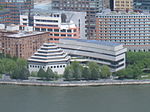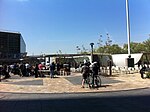Skyscraper Museum

The Skyscraper Museum is an architecture museum located in Battery Park City, Manhattan, New York City and founded in 1996. As the name suggests, the museum focuses on high-rise buildings as "products of technology, objects of design, sites of construction, investments in real estate, and places of work and residence." The Skyscraper Museum also celebrates the architectural heritage of New York and the forces and people who created New York's skyline. Before moving to the current and permanent location in Battery Park City in 2004, the museum was a nomadic institution, holding pop-up exhibitions in four temporary donated spaces around Lower Manhattan since 1996. The Skyscraper Museum was founded and is directed by Carol Willis, a professor of architectural history and urban studies at Columbia University. It includes two exhibition spaces for both permanent and temporary exhibitions, a bookstore, and a mezzanine with its office, situated above the bookstore. The museum can be reached by a ramp starting in the basement.
Excerpt from the Wikipedia article Skyscraper Museum (License: CC BY-SA 3.0, Authors, Images).Skyscraper Museum
Battery Place, New York Manhattan
Geographical coordinates (GPS) Address Nearby Places Show on map
Geographical coordinates (GPS)
| Latitude | Longitude |
|---|---|
| N 40.705555555556 ° | E -74.0175 ° |
Address
Millennium Point
Battery Place
10280 New York, Manhattan
New York, United States
Open on Google Maps







